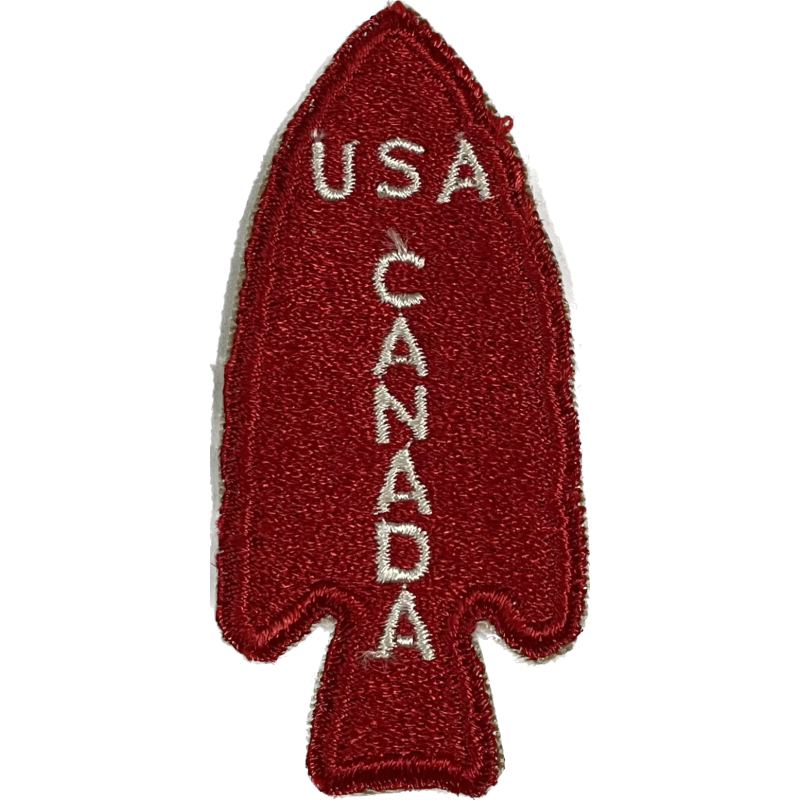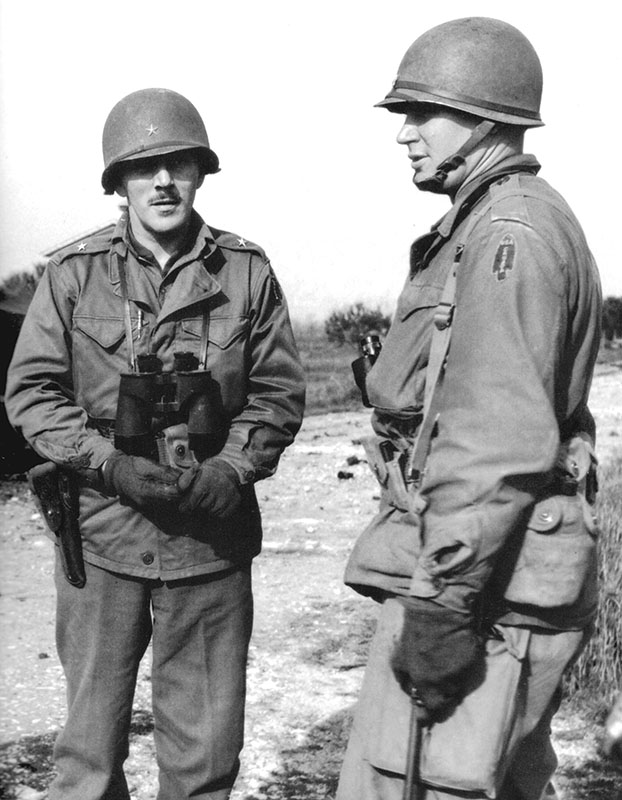




Genuine WWII US shoulder insignia of the First Special Service Force. Aleutian Islands, 1943,Italy, 1943, Anzio, 1944, France, 1944.
Original WWII manufacture, 100% cotton.

The First Special Service Force was activated on 9 July 1942 as a joint Canadian-US force of three small regiments and a service battalion.
Aleutian Islands, 1943
On 10 July the Devil's Brigade sailed for the Aleutian Islands of Alaska. On 15 August 1943, FSSF was part of the invasion force of the island of Kiska, but after discovering the island was recently evacuated by Japanese forces, it re-embarked and returned to Fort Ethan Allen, arriving 9 September.
Italy, 1943
The original operation codenamed "Project Plough," a mission to parachute into German-held Norway to knock out strategic targets such as hydroelectric power plants, was abandoned, but in October 1943, the commander of the Fifth United States Army, Lt. Gen. Mark W. Clark, brought the First Special Service Force to Italy where its members demonstrated the value of their unique skills and training. The Devil's Brigade arrived in Casablanca in French Morocco in November 1943 and quickly moved to the Italian front arriving at Naples on 19 November 1943 and immediately going into the line with the US 36th Infantry Division.
At Monte La Difensa, written like this by a misprint on the 1942 military maps (in fact the exact name is Monte La Defensa), which is part of the ancient town of Rocca d'Evandro (about 10 miles south east of Cassino) and which was part of the Bernhardt Line Defences on the Camino hill mass, between 3 December and 6 December 1943, they immediately earned a reputation for being able to take impenetrable objectives when no one else could. Here, in the dead of winter, the First Special Service Force wiped out a strategic enemy defensive position that sat high atop a mountain surrounded by steep cliffs. They climbed the cliffs on the north face of the mountain using only ropes in the dead of night and caught the Germans by surprise. Previously, American and British forces had suffered many casualties in futile attempts to take the important Camino Ridge. The FSSF was successful in taking their initial objective of La Defensa but were delayed in obtaining their actual objective of Monte La Remetanea (Hill 907). The attack on 907 was halted after the death of the 1st Battalion CO Lt. Col. T.C. MacWilliam. While he desired that the Force momentum continue, Frederick ordered a halt in the advance on 907 in order to wait for reinforcements and supplies. The British were also having difficulties taking the main objective of Monte Camino to the Force's left. The successful assault on Defensa was the basis for the 1968 motion picture titled The Devil's Brigade.
The FSSF immediately continued its attack, assaulting Monte La Remetanea from 6 December to 9 December. It captured Hill 720, starting from Monte Sammucro on 25 December, and after difficulties assaulted Monte Majo and Monte Vischiataro almost simultaneously on 8 January 1944. During the mountain campaign the FSSF suffered 77% casualties.
Anzio, 1944
Personnel being briefed before setting out on a patrol at the Anzio beachhead, the Special Force brigade was withdrawn from the mountains in January and on February 1 was landed at the beachhead created by Operation Shingle at Anzio, south of Rome, replacing the 1st and 3rd Ranger Battalions, which had suffered heavy losses at the Battle of Cisterna. Their task was to hold and raid from the right-hand flank of the beachhead marked by the Mussolini Canal/Pontine Marshes. Shortly after the FSSF took over the Mussolini Canal sector, German units pulled back up to a half-mile to avoid their aggressive patrols.
It was at Anzio that the Germans dubbed the First Special Service Force the "Devil's Brigade." The diary of a dead German soldier contained a passage that said, "The black devils (Die schwarzen Teufel) are all around us every time we come into the line." The soldier was referring to them as "black" because the brigade's members smeared their faces with black boot polish for their covert operations in the dark of the night. During Anzio, the FSSF fought for 99 days without relief. It was also at Anzio that the FSSF used their trademark stickers; during night patrols soldiers would carry stickers depicting the unit patch and a slogan written in German: "Das dicke Ende kommt noch," said to translate to "The Worst is yet to Come", placing these stickers on German corpses and fortifications. Canadian and American members of the Special Force who lost their lives are buried near the beach in the Commonwealth Anzio War Cemetery and the American Cemetery in Nettuno, just east of Anzio.
When the 5th Army breakout offensive began on 25 May 1944, the FSSF was sent against Monte Arrestino, and attacked Rocca Massima on 27 May. The FSSF was given the assignment of capturing seven bridges in the city to prevent their demolition by the withdrawing Wehrmacht. During the night of 4 June, members of the FSSF entered Rome. They are among the Allied units to be the first to enter Rome. After they secured the bridges, they quickly moved north in pursuit of the retreating Germans.
France, 1944
On 14 August 1944, the FSSF landed at Îles d'Hyères during Operation Dragoon, the invasion of southern France. On 22 August it was attached to the 1st Airborne Task Force, a provisional Seventh Army airborne division, and later made part of the Task Force. On 7 September it moved with the 1st Airborne Task Force to defensive positions on the Franco-Italian border. During the war the 1,800-man unit accounted for some 12,000 German casualties, captured some 7,000 prisoners, and sustained an attrition rate of over 600%.